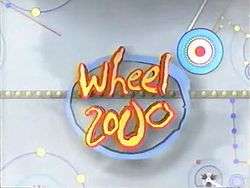Wheel 2000
| Wheel 2000 | |
|---|---|
 | |
| Genre | Game show |
| Created by |
Scott Sternberg based on Wheel of Fortune created by Merv Griffin |
| Directed by | James Marcione[1] |
| Presented by |
David Sidoni with "Cyber Lucy" (Voiced by Tanika Ray) |
| Theme music composer | Dan Sawyer[1] |
| Country of origin | United States |
| Original language(s) | English |
| No. of seasons | 1 |
| No. of episodes | 22 |
| Production | |
| Executive producer(s) | Scott Sternberg[1] |
| Location(s) | Sony Pictures Studios, Culver City, California |
| Running time | approx. 22-26 minutes |
| Production company(s) |
Scott Sternberg Productions Columbia TriStar Television |
| Release | |
| Original network | CBS, Game Show Network |
| Original release | September 13, 1997 – February 7, 1998 |
Wheel 2000 (also known as Wheel of Fortune 2000) is a children's version of the American game show Wheel of Fortune. The show was created by Scott Sternberg and was hosted by David Sidoni, with Tanika Ray providing voice work and motion capture for a virtual reality hostess named "Cyber Lucy".[2] The show premiered on September 13, 1997 on CBS, aired as part of the network's attempt to meet the then-new E/I mandates during its Saturday morning block, and ran through February 7, 1998 with repeats continuing through September 26. Game Show Network broadcast Wheel 2000's episodes concurrently with their airings on CBS.
Gameplay
The gameplay of Wheel 2000 was very similar to the adult version, except children aged 10–15 competed for points and prizes instead of cash with the eventual winner playing for a grand prize in the bonus round. Round categories were chosen by the contestants from a possible three; the names of the categories were updated to reflect the younger contestants ("Place", for example, became "Globetrotter"). New categories replaced those chosen in each round. In Round 1, the coin toss winner/the red player would choose, Round 2, the yellow player, Round 3, the blue player and so on. Contestants received a prize for solving each puzzle. The player who solved the puzzle also added the points to their bank, with the eventual top winner advancing to the Bonus Round. After each round, Cyber Lucy (or a celebrity) presented a short video clip related to the solved puzzle. Vowels cost 250 points.[1] Games were typically played to three rounds, with top point values of 1,000, 2,000, and 5,000.[1]

The wheel featured a special wedge on which a contestant could choose to play a pre-determined stunt to earn up to three extra letters.[1] There was also a "WWW.WHEEL2000.COM"[3]wedge, which allowed a home viewer who had previously registered on the site to win Wheel 2000 merchandise if a contestant hit the wedge and called a consonant that appeared in the puzzle. The Lose a Turn wedge was here named the "Loser" spot; in place of the Bankrupt wedge was "The Creature", which, if the contestant landed on that wedge, would prompt the wheel to rise, belch smoke, and cause an unseen creature to "eat" the contestant's points.[4] Other special wedges included Double Up, which awarded double its value per letter if a contestant correctly answered a trivia question, and a Prize Box, which functioned identically to the special prize wedges on the adult version (except the kids were allowed to keep the prize whether they solved the puzzle or not and the value was not added to their score).[1] The bonus round was played in almost identical fashion to the adult version, including the adult categories, except that prizes were determined by selecting from two envelopes labeled "A" or "B" (instead of the five choices in the adult version at the time).[1]
12-city tour
In early 1998, Wheel 2000 made a 12-city tour, appearing in shopping malls around the country. The Discover-branded tour, coordinated by the Chicago office of New Jersey-based promotion agency DVC Group, also featured Sidoni as host, with Ray as Lucy joining him again. The tour visited a variety of major market cities: Chicago, Philadelphia, Pittsburgh, Washington D.C., New York City, Charlotte, Dallas, Denver, Salt Lake City, Seattle, San Jose, and Anaheim. Winners from each market were invited to appear as contestants on the program in a grand finale.[5]
International versions
| Country | Local Name | Host | Network | Year Aired |
|---|---|---|---|---|
| |
Kinder-Glücksrad | Petra Hausberg | Sat.1 | 1992-1993 |
| |
Çark 2000 | Ataman Erkul | Kanal D | 2000 |
| |
Chiếc nón kỳ diệu 2000 | VTV3 | 2007-2009 |
References
- 1 2 3 4 5 6 7 8 Schwartz, David; Ryan, Steve; Wostbrock, Fred (1999). The Encyclopedia of TV Game Shows (3 ed.). Facts on File, Inc. p. 252. ISBN 0-8160-3846-5.
- ↑ http://nl.newsbank.com/nl-search/we/Archives?p_product=AASB&p_theme=aasb&p_action=search&p_maxdocs=200&p_topdoc=1&p_text_direct-0=0EA05A5128D85CB2&p_field_direct-0=document_id&p_perpage=10&p_sort=YMD_date:D&s_trackval=GooglePM
- ↑ "Official Website of Wheel 2000 (courtesy of Wayback Archive)". Archived from the original on December 12, 1998. Retrieved April 21, 2016.
- ↑ "Series Premiere". Wheel of Fortune 2000. September 13, 1997. CBS; Game Show Network.
- ↑ Williams, Jeffrey. "Game Youths Can Try Luck at Wheel in Traveling Show at Navy Pier".